Marie Auguste Emile Rene Menard Paintings
Émile René Ménard was a French painter, born on April 15, 1862, in Paris, France. He was closely associated with the Symbolist movement and Post-Impressionism, but his style also embraced elements of Classicism, distinguishing his body of work with a unique blend of modern and traditional aesthetics. Ménard received his artistic training at the École des Beaux-Arts in Paris under the guidance of academic painters like Henri Lehmann and later, through his association with Puvis de Chavannes, a leading Symbolist artist, from whom he absorbed significant influences.
Ménard's work is characterized by serene landscapes, mythological themes, and a muted, harmonious palette that evokes a sense of timeless calm. His paintings often depicted classical landscapes imbued with a mystical or dreamlike quality, reflecting his interest in ancient Greek and Roman cultures as well as his affinity for the natural world. Ménard also explored the female form in his work, treating it with a soft, ethereal touch that added to the overall dreaminess of his compositions.
Throughout his career, Ménard exhibited his work extensively. He participated in the Salon des Artistes Français, where he received several honors, and his paintings were also shown in international exhibitions, such as the Exposition Universelle in Paris. Despite his connection with prominent movements of the time, Ménard maintained a degree of independence in his work, which often set him apart from his contemporaries.
Ménard was not only a painter but also engaged in printmaking and mural painting, showcasing his versatility as an artist. His murals can be found in public buildings in Paris, demonstrating his ability to translate his poetic and idyllic visions onto a larger scale.
Émile René Ménard's legacy is marked by his contribution to the Symbolist movement and his successful fusion of classical themes with a modern sensibility. Despite being less well-known than some of his contemporaries, his work continues to be appreciated for its beauty, tranquility, and the artist's skill in capturing the ethereal nature of the world around him. Émile René Ménard died on February 13, 1930, in Paris, leaving behind a body of work that continues to captivate and inspire.









